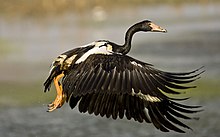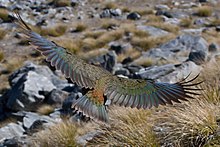Wing shape and flight
The shape of the wing is an important factor in determining the types of flight of which the bird is capable. Different shapes correspond to different trade-offs between beneficial characteristics, such as speed, low energy use, and maneuverability. The
planform of the wing (the shape of the wing as seen from below) can be described in terms of two parameters,
aspect ratio and
wing loading. Aspect ratio is the ratio of
wingspan to the mean of its
chord (or the square of the wingspan divided by wing area). Wing loading is the ratio of weight to wing area.
Most kinds of bird wing can be grouped into four types, with some falling between two of these types. These types of wings are elliptical wings, high speed wings, high aspect ratio wings and soaring wings with slots.
- Elliptical wings
Elliptical wings are short and rounded, having a low aspect ratio, allowing for tight maneuvering in confined spaces such as might be found in dense vegetation. As such they are common in forest raptors (such as
Accipiter hawks), and many
passerines, particularly non-migratory ones (migratory species have longer wings). They are also common in species that use a rapid take off to evade predators, such as
pheasants and
partridges.
- High speed wings
High speed wings are short, pointed wings that when combined with a heavy wing loading and rapid wingbeats provide an energetically expensive high speed. This type of flight is used by the bird with the fastest wing speed, the
peregrine falcon, as well as by most of the
ducks. The same wing shape is used by the
auks for a different purpose; auks use their wings to "fly" underwater. The Peregrine Falcon has the highest recorded dive speed of 175 mph (282 km/h). The fastest straight, powered flight is the
Spine-tailed Swift at 105 mph (170 km/h).

A
Roseate Tern uses its low wing loading and high aspect ratio to achieve low speed flight
- High aspect ratio wings
High aspect ratio wings, which usually have low wing loading and are far longer than they are wide, are used for slower flight, almost hovering (as used by
kestrels,
terns and
nightjars) or alternatively by birds that specialize in soaring and
gliding flight, particularly that used by
seabirds,
dynamic soaring, which use different wind speeds at different heights (
wind shear) above the waves in the ocean to provide lift. Low speed flight is important for birds that plunge dive for fish.
- Soaring wings with deep slots
These are the wings favored by the larger species of inland birds, such as
eagles,
vultures,
pelicans, and
storks. The slots at the end of the wings, between the primaries, reduce the
induced drag and
wingtip vortices by "capturing" the energy in air flowing from the lower to upper wing surface at the tips
[citation needed], whilst the shorter size of the wings aids in takeoff (high aspect ratio wings require a long
taxi in order to get airborne).
[edit] Hovering
Hovering is used by several species of birds (and specialized in by one family). True hovering, which is generating lift through flapping alone rather than as a product of the bird's passage through the air, demands a lot of energy. This means that it is confined to smaller birds; the largest bird able to truly hover is the
pied kingfisher, although larger birds can hover for short periods of time. Larger birds that hover for prolonged periods do so by flying into a headwind, allowing them to remain stationary relative to the ground (or water). Kestrels, terns and even hawks use this windhovering.
Most birds that hover have high aspect ratio wings that are suited to low speed flying. One major exception to this are the
hummingbirds, which are the most accomplished hoverers of all the birds. Hummingbird flight is different from other bird flight in that the wing is extended throughout the whole stroke, the stroke being a symmetrical figure of eight, with the wing producing lift on both the up- and down-stroke. Some hummingbirds can beat their wings 52 times a second, though others do so less frequently.
[edit] Take-off and landing

A male
bufflehead runs atop the water while taking off
Take-off is one of the most energetically demanding aspects of flight, as the bird needs to generate enough airflow across the wing to create lift. With small birds a jump up will suffice, while for larger birds this is not possible. In this situation, birds need to take a run up in order to generate the airflow to take off. Large birds take off by facing into the wind, or, if they can, by perching on a branch or cliff so that all they need to do is drop off into the air.
Landing is also a problem for large birds with high wing loadings. This problem is dealt with in some species by aiming for a point below the intended landing area (such as a nest on a cliff) then pulling up beforehand. If timed correctly, the airspeed once the target is reached is virtually nil. Landing on water is simpler, and the larger waterfowl species prefer to do so whenever possible, landing into wind and using their feet as skids. In order to lose height rapidly prior to landing, some large birds such as geese indulge in a rapid alternating series of
sideslips in a maneuver termed as
whiffling.



















































